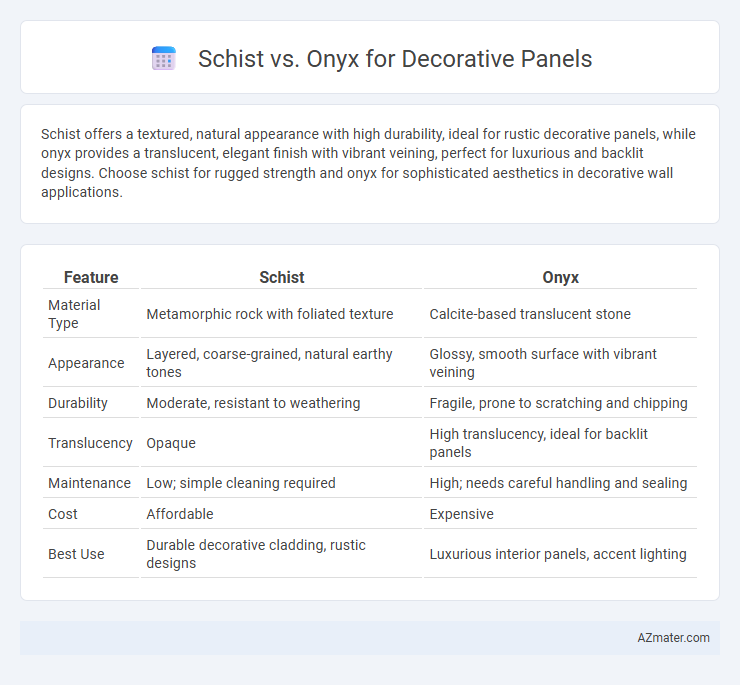Schist offers a textured, natural appearance with high durability, ideal for rustic decorative panels, while onyx provides a translucent, elegant finish with vibrant veining, perfect for luxurious and backlit designs. Choose schist for rugged strength and onyx for sophisticated aesthetics in decorative wall applications.
Table of Comparison
| Feature | Schist | Onyx |
|---|---|---|
| Material Type | Metamorphic rock with foliated texture | Calcite-based translucent stone |
| Appearance | Layered, coarse-grained, natural earthy tones | Glossy, smooth surface with vibrant veining |
| Durability | Moderate, resistant to weathering | Fragile, prone to scratching and chipping |
| Translucency | Opaque | High translucency, ideal for backlit panels |
| Maintenance | Low; simple cleaning required | High; needs careful handling and sealing |
| Cost | Affordable | Expensive |
| Best Use | Durable decorative cladding, rustic designs | Luxurious interior panels, accent lighting |
Introduction to Schist and Onyx Decorative Panels
Schist decorative panels feature natural foliated metamorphic rock known for its layered texture and earthy tones, delivering a rugged yet elegant appearance for interior design. Onyx decorative panels consist of translucent calcium carbonate with unique veining patterns and a smooth, polished finish, often illuminated to enhance its luxurious and sophisticated aesthetic. Both materials offer distinct visual appeal and durability, making them popular choices for upscale wall cladding and architectural applications.
Geological Origins: Schist vs Onyx
Schist originates from regional metamorphism of sedimentary rocks and is characterized by its foliated texture due to aligned minerals like mica. Onyx, a form of banded chalcedony, forms through the deposition of silica in cold water environments, creating distinct, parallel layers without foliation. Understanding these geological origins highlights schist's natural cleavage, ideal for textured panels, while onyx offers translucent, layered aesthetics favored in decorative applications.
Unique Visual Characteristics
Schist features a natural, layered texture with varied mineral grains that create a rugged, earthy appearance, ideal for adding organic depth to decorative panels. Onyx offers a translucent quality with striking, swirling patterns and vibrant color variations, producing a luxurious and luminous effect. The contrast between Schist's coarse, matte finish and Onyx's smooth, polished surface highlights their distinct aesthetic appeal for interior design.
Durability and Longevity Comparison
Schist offers high durability with its foliated texture and resistance to weathering, making it suitable for long-lasting decorative panels in both indoor and outdoor applications. Onyx, while prized for its translucent beauty and luxurious appearance, is softer and more prone to scratching and impact damage, limiting its longevity in high-traffic or exterior settings. For durability and extended lifespan, schist is generally the superior choice compared to onyx in decorative panel installations.
Versatility in Interior Design
Schist offers a unique textured appearance with natural variations, making it ideal for creating rustic or earthy interior designs that require a rugged, organic feel. Onyx, prized for its translucency and rich color patterns, enables designers to incorporate backlighting techniques, adding depth and drama to modern or luxurious spaces. Both materials provide versatile options for decorative panels, with schist enhancing tactile appeal and onyx delivering sophisticated elegance.
Installation Challenges and Considerations
Schist's natural foliation and uneven surface require careful handling during installation to prevent chipping or breaking, demanding skilled labor and proper adhesive selection for secure mounting. Onyx panels, known for their translucency and brittleness, pose challenges that necessitate precise cutting and support systems to avoid cracking and ensure structural integrity. Both materials require moisture control and appropriate backing to maintain longevity and aesthetic appeal in decorative panel applications.
Maintenance and Care Requirements
Schist decorative panels require regular sealing and occasional resealing to maintain their durability and prevent moisture absorption, as their natural cleft surfaces can trap dirt and stains. Onyx panels necessitate more careful maintenance due to their softer, more porous nature; they need gentle cleaning with pH-neutral products and protection from acidic substances to avoid etching and discoloration. Both materials benefit from routine dusting and avoiding abrasive cleaners to preserve their aesthetic appeal and longevity.
Cost Analysis: Schist vs Onyx Panels
Schist panels generally offer a more cost-effective option for decorative paneling compared to onyx, with prices typically ranging between $30 to $50 per square foot, while onyx panels can cost upwards of $100 to $150 per square foot due to their rarity and translucence. Installation costs for both materials vary depending on size and complexity, but onyx often requires specialized labor and backing to support its fragile nature, increasing overall expenses. Maintenance and durability factors also influence long-term costs, as schist provides better scratch resistance and less susceptibility to staining relative to onyx.
Sustainability and Environmental Impact
Schist and onyx offer distinct sustainability profiles for decorative panels, with schist being a more eco-friendly choice due to its natural abundance and lower extraction impact compared to the rare and energy-intensive mining of onyx. Schist's durability and minimal processing requirements reduce carbon emissions throughout its lifecycle, making it suitable for environmentally conscious projects. Onyx, while visually striking, involves higher embodied energy and often requires intensive quarrying practices, increasing its environmental footprint.
Choosing the Right Stone for Your Space
Schist offers a textured, layered appearance with natural mineral flecks that enhance visual depth, ideal for rustic or earthy decorative panels that emphasize warmth and character. Onyx, prized for its translucency and smooth, vibrant veining patterns, creates a dramatic, luxurious aesthetic suited for modern, high-end interiors with backlit features. When choosing between schist and onyx for decorative panels, consider factors such as desired light interaction, durability, maintenance requirements, and the overall ambiance you want to achieve in your space.

Infographic: Schist vs Onyx for Decorative Panel
 azmater.com
azmater.com